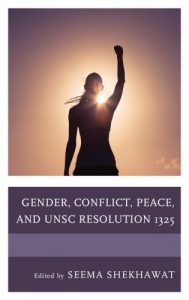Gender, Conflict, Peace, and UNSC Resolution 1325
edited by Seema Shekhawat, Lexington Books, 2018
Reviewed by Sarah Douglas
 This new volume, edited by Seema Shekhawat, makes a significant contribution to the body of good practice and analysis on the implementation of Security Council Resolution 1325 (adopted in 2000). Nearly 18 years after the unanimous adoption of 1325, women’s participation in peace and security decision-making and the protection of women and girls in situations of conflict and post-conflict remain inadequate. A growing body of evidence points to the positive impact that
This new volume, edited by Seema Shekhawat, makes a significant contribution to the body of good practice and analysis on the implementation of Security Council Resolution 1325 (adopted in 2000). Nearly 18 years after the unanimous adoption of 1325, women’s participation in peace and security decision-making and the protection of women and girls in situations of conflict and post-conflict remain inadequate. A growing body of evidence points to the positive impact that
women’s participation has on peacemaking, peacebuilding, and peacekeeping. And, women’s right to participate equitably is enshrined in normative agreements ranging from the Security Council to the Geneva-based treaty bodies and international jurisprudence.
And yet, with each new peace process, women and gender equality advocates must renegotiate and justify their participation again. The introductory chapter of this volume explains the reason simply: patriarchy. As opposed to other aspects of the liberal peacebuilding project, the women, peace, and security agenda must grapple with entrenched bias and discrimination that privileges male-dominated and state-centric narratives of security. While the contexts analysed in the book vary from rural Nigeria to Israel, Myanmar, Cyprus, and global policy forums, the overarching theme of the book underscores the urgency of adopting feminist analysis and feminist approaches in order to grapple with peace and security challenges around the globe.
The book sheds light on several under-researched areas within the women, peace, and security agenda. Too often, women, peace, and security advocacy has fallen into binary terms where women’s participation is contrasted with masculine security narratives and spaces. The chapters in the volume that focus on widowhood, rural women peacebuilders, and migrant women force the reader to unpack the intersectionality that women and girls experience throughout the conflict
cycle. Imbued with strong feminist sensibility, the chapters address the limitations of promoting women’s participation without deconstructing power dynamics at the local, national, and global levels.
UN Women’s Global Study on 1325, published in 2015 (Coomaraswamy 2015), highlighted the need to improve linkages between 1325 and the human rights architecture of the United Nations as a tool towards increased accountability to women, peace, and security commitments. The chapters in Seema Shekhawat’s collection, on CEDAW(Convention on the Elimination of All Forms of Discrimination Against Women) and National Actions Plans (NAPs; which countries develop in order to demonstrate how they will incorporate provisions of 1325 into policy and practice), will help decision-makers analyse the intersections between the human rights and women, peace, and security frameworks. However, it should be noted that NAPs on 1325 do not have equivalent status as UN conventions in terms of the obligations and need for compliance that these would imply for states parties. NAPs are policy documents and, in the best cases, implementation frameworks, but they lack the weight of a UN convention that has been ratified. While NAPs are a welcome signal of political commitment, their variation and the lack of standardised approaches to design and implementation render analysis and comparison complicated. Thus, the analysis on NAPs in several
chapters overstates the influence and traction that NAPs may have in most countries.
However, the book really adds value to the women, peace, and security discourse through the country case studies. Recognising the hegemonic masculinity that dominates peace and security thought and practice, the case studies shed light on the gendered dynamics of peace at the national level, and the complex and varied roles that women play as peacebuilders and stakeholders in peacemaking. From the margins to the centre, the chapters deconstruct the simplistic assumptions
about women’s presence in peace processes in Colombia, Myanmar, Israel/Palestine, Nigeria, and Pakistan, to probe at the transformative influence of feminist approaches, as well as the limitations of perfunctory assessments of presence.
This book is an ideal text to improve the understanding and relevance of the women, peace, and security agenda amongst a mainstream academic and policy audience. For advocates and specialists working on mainstreaming gender in the situations covered in the volume, the analysis provides extremely useful evidence and historical context for their efforts to promote implementation of 1325. The chapters are accessible and engaging, while the case studies are highly topical and relevant for ongoing policy debates around sustaining peace and the Sustainable Development Goals. In April 2018, the President of the General Assembly organised a high-level meeting on Sustaining Peace, where ministers and other decision-makers universally acknowledged the urgency of transforming our current peace and security paradigm to one that is more inclusive, preventive, and resilient – all concepts enshrined in Resolution 1325. Seema Shekhawat’s text provides
compelling analysis of the necessity to implement the resolution with the utmost urgency.
Reference
Coomaraswamy, Radhika (2015) Preventing Conflict, Transforming Justice, Securing the Peace: A Global Study on the Implementation of United Nations Security Council 1325, New York: UN Women.
Sarah Douglas
© 2018 Deputy Chief, Peace and Security, UN Women
Review originally published in Gender & Development 26(2) July 2018
